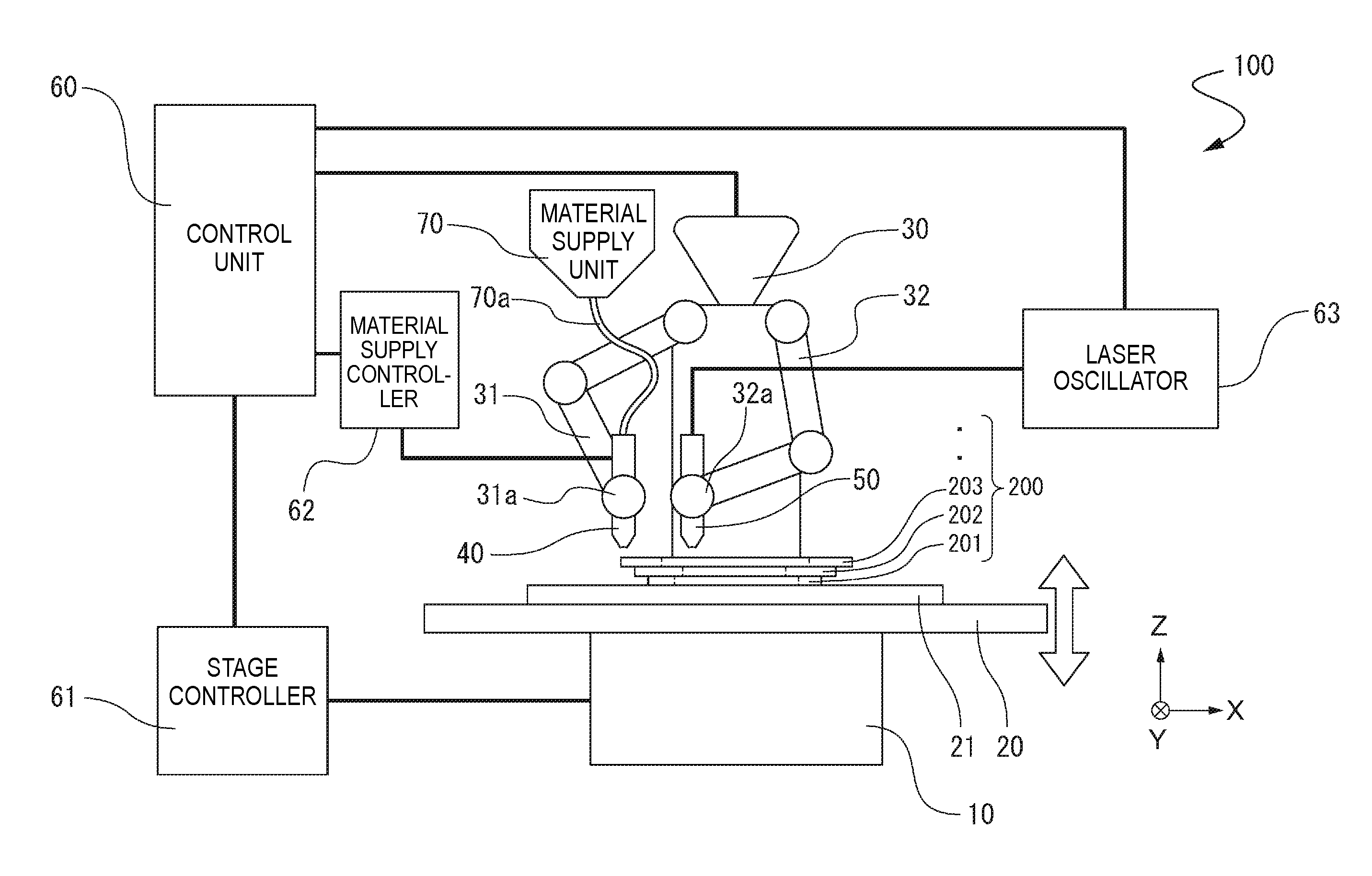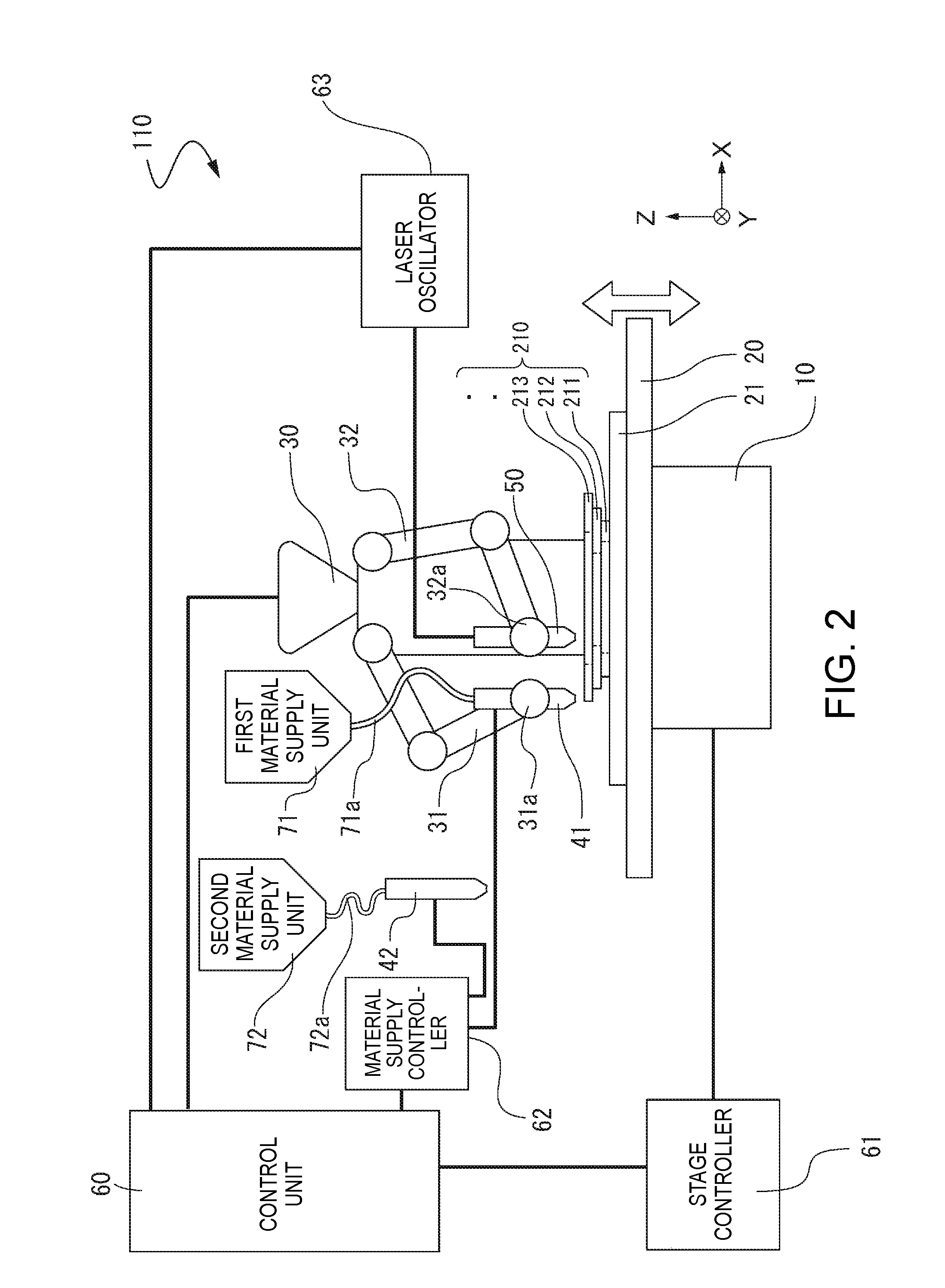Three-dimensional forming apparatus and three-dimensional forming method
- Summary
- Abstract
- Description
- Claims
- Application Information
AI Technical Summary
Benefits of technology
Problems solved by technology
Method used
Image
Examples
first embodiment
[0045]FIG. 1 is a schematic diagram illustrating the configuration of a three-dimensional forming apparatus according to a first embodiment. In the present specification, “three-dimensional forming” refers to forming a so-called stereoscopically fabricated object and includes, for example, forming a shape having a thickness even when the shape is a flat shape or a so-called two-dimensional shape.
[0046]As illustrated in FIG. 1, a three-dimensional forming apparatus 100 includes a base 10, a stage 20 included to be able to be driven in the Z direction illustrated in the drawing by a driving unit (not illustrated) included in the base 10, and a robot 30 serving as a driving unit that holds a material supply unit and a heating unit to be described below and is able to move the material supply unit and the heating unit. On the stage 20, partial fabricated objects 201, 202, and 203 are formed in layer states while being formed in a three-dimensional fabricated object 200. As will be descr...
second embodiment
[0059]FIG. 2 is a schematic diagram illustrating the configuration of a three-dimensional forming apparatus according to a second embodiment. In a three-dimensional forming apparatus 110 illustrated in FIG. 2, a plurality of kinds of supply materials, two kinds of supply materials in the embodiment, are used compared to the three-dimensional forming apparatus 100 according to the first embodiment. The same reference numerals are given to the same constituent elements as those of the three-dimensional forming apparatus 100 according to the first embodiment, and the description thereof will be omitted.
[0060]As illustrated in FIG. 2, the three-dimensional forming apparatus 110 includes a first material supply unit 71 and a second material supply unit 72. A first supply tube 71a serving as a material supply path is extended to the first material supply unit 71 and a first nozzle 41 is connected to the end of the first supply tube 71a. Similarly, a second supply tube 72a serving as a mat...
third embodiment
[0064]FIGS. 3A and 3B are diagrams illustrating the configuration of a three-dimensional forming apparatus 120 according to a third embodiment. The three-dimensional forming apparatus 120 illustrated in FIG. 3A according to the embodiment has a different configuration of the heating unit from the three-dimensional forming apparatus 100 according to the first embodiment. The same reference numerals are given to the same constituent elements as those of the three-dimensional forming apparatus 100 according to the first embodiment, and the description thereof will be omitted.
[0065]As illustrated in FIG. 3A, the three-dimensional forming apparatus 120 includes a hot wind blowing mechanism 90 as a heating unit. The hot wind blowing mechanism 90 includes a compressor 91, a gas supply unit 92, and a duct 93. The hot wind blowing mechanism 90 is controlled by a hot wind blowing mechanism controller 64 connected to the control unit 60.
[0066]The compressor 91 includes a compression unit compr...
PUM
| Property | Measurement | Unit |
|---|---|---|
| Composition | aaaaa | aaaaa |
| Energy | aaaaa | aaaaa |
Abstract
Description
Claims
Application Information
 Login to View More
Login to View More - R&D
- Intellectual Property
- Life Sciences
- Materials
- Tech Scout
- Unparalleled Data Quality
- Higher Quality Content
- 60% Fewer Hallucinations
Browse by: Latest US Patents, China's latest patents, Technical Efficacy Thesaurus, Application Domain, Technology Topic, Popular Technical Reports.
© 2025 PatSnap. All rights reserved.Legal|Privacy policy|Modern Slavery Act Transparency Statement|Sitemap|About US| Contact US: help@patsnap.com



